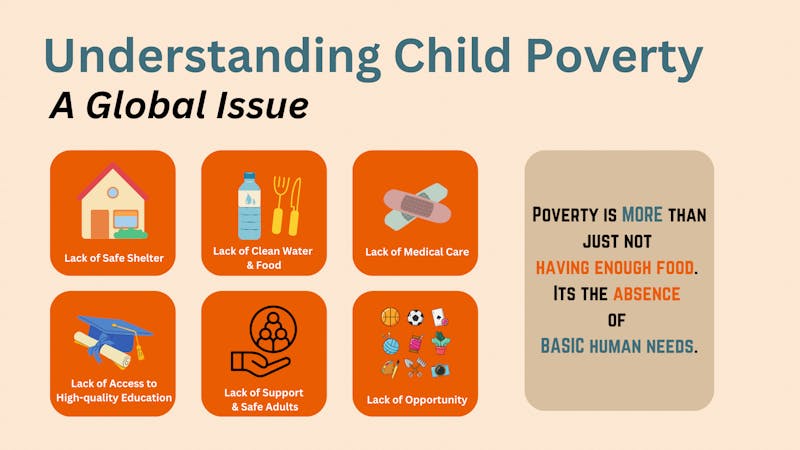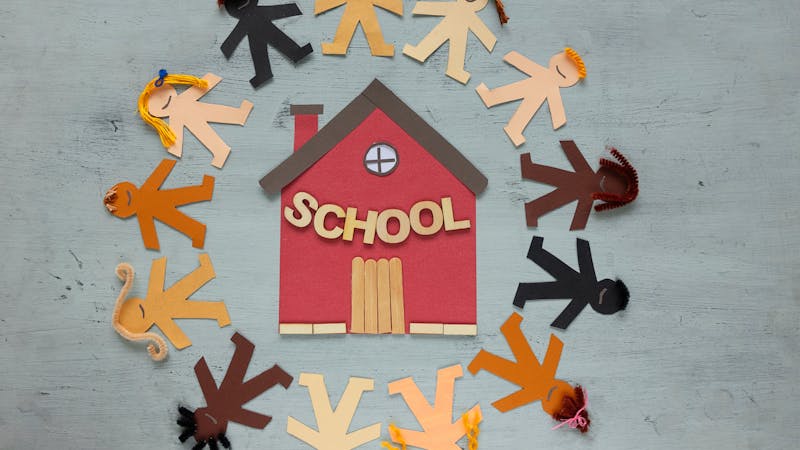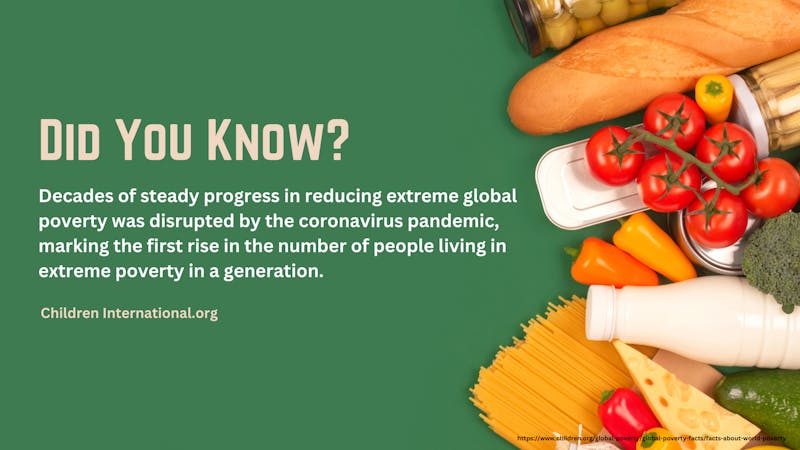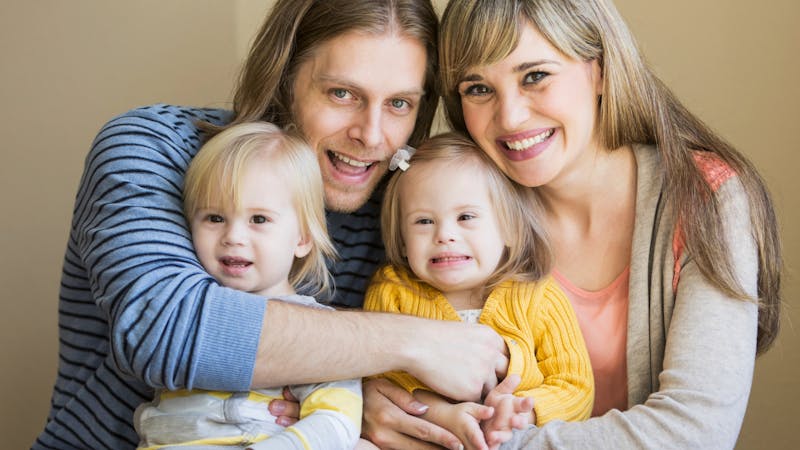An Educational Guide to Alleviating Child Poverty
Author: Sarah Perowne
Last update: 11/28/2025

Poverty, by its simplest definition, is the absence of basic human needs. For many worldwide, this could be food, water, or shelter, but often, it's a combination of many things, including a lack of high-quality education, which further aggravates the situation. Although children make up around a third of the global population, a staggering half of all impoverished people are children, arguably during one of the most important stages of human development.
In this article, we will try to turn the tables and shift such a negative and upsetting statistic into a list of actionable resources and ideas. With this educational guide, we hope you can walk away with valuable knowledge of alleviating poverty in children. Let's get started!
Understanding Child Poverty and the Signs
The United States defines child poverty by following the guidelines of the Office of Management and Budget (OMB). Using various indexes, studies, and adjusting for inflation, the OMB has the salary threshold for an impoverished family set to $29,678. This is known as the Official Poverty Measure (OPM).
However, there are additional steps that could classify a family as impoverished; these are known as the Supplemental Poverty Measure (SPM). The SPM considers geography, housing expenses like federal taxes, state taxes, work expenses, and medical expenses.
So, how do these measures pertain to children in poverty? In 2022, the SPM child poverty rate more than doubled, increasing from 5.2% in 2021 to 12.4% in 2022. This substantial increase in child poverty can be attributed to changes in federal tax policy, making the need to understand poverty more important than ever.
Child poverty can manifest in so many different ways, making identifying the root cause of the problem that much harder. Limited access to food, housing, or clothing, insufficient healthcare or nutritional care, a lack of education, attention deficits due to overcrowding, abuse in various forms, and even the stress of raising other children. That list is just a snapshot of some impoverished children's lives and their struggles.
Let's take a look at how to fight some of these issues.
How an Accessible Education Can Alleviate Child Poverty
Let's begin with education. An accessible and inclusive education plays a crucial role in breaking the cycle of child poverty. It does this by empowering children with the knowledge and life skills to go further than those before them. If we look at developing countries worldwide, an educational center or program is usually one of the first initiatives you'll see emerge, and for good reason! Education can change both individuals and communities for the better.
Whether we're talking proficiency in language, basic math, or exploring arts and culture, accessible education can illuminate paths for children. Even homeschooling, a popular schooling method throughout the United States, can provide all the flexibility and personalized learning a child needs without the pressure of other people and opinions. There are so many success stories of poverty-struck children going on to be scientists, engineers, actors, and artists; just look at Dolly Parton or Oprah!
Using Resources Wisely to Alleviate Child Poverty
There are a lot of resources, programs, and initiatives, all with the same aim of combating child poverty. However, the efficacy of these can differ. As organizations and charities will know, it's important to allocate resources in the right places and to keep up to date with ever-changing government aid, schemes, and policies; otherwise, poverty reduction efforts are fruitless.
Promoting Effective Programs and Initiatives
Our list of the current programs and initiatives aiming to relieve child poverty is mainly for the USA, but some are worldwide. For updated U.S.-based information, please refer to the USA Gov website. You will find information on government benefits, initiatives, and local services there, as well as information about discontinued programs and what support can be accessed instead.
A global organization that works with local NGOs and organizations in marginalized areas to alleviate worldwide poverty.
International worldwide organization aiming to promote a fair and inclusive society for everyone, free from conflict and poverty. Their Knowledge Hub index is full of resources and statistics, and their Global Hunger Index, in collaboration with WeltHungerHilfe, is a leading peer-reviewed annual report on worldwide poverty.
The Children's Defense Fund is fighting for every child in America to ensure they have what they need to thrive. Their CDF Freedom Schools program gives children across the U.S. access to high-quality resources.
An initiative by the Catholic Campaign for Human Development, Poverty USA is an extensive educational resource to help communities and individuals address the root causes of economic disparity and injustice. Listen to real stories of those affected by poverty and how you can get involved.
The NCCP works at a grassroots level to improve the lives of low-income children across the USA. The NCCP policy tracker is constantly updated to include state-wide initiatives that families across the U.S. are eligible for.
It's a fact. No kid should go hungry in 2023. Still, according to No Kid Hungry, run by the non-profit Share Our Strength, 1 in 8 kids in the USA are growing up with no food. People can donate to the non-profit and educate themselves on poverty statistics.
Advocacy and Policies for Combating Child Poverty
When it comes to combating child poverty and upholding basic human rights, advocacy, being an ally, and educating yourself on policies that could help are important.
Advocacy, in particular, plays a crucial role. Fighting against child poverty is more than just hashtags on Instagram and yearly campaigns; it's an ongoing struggle. Still, you can make a difference by continuously raising awareness and pushing for policy changes that address the root causes of child poverty, like immigration, inequality, and unequal distribution of resources, depending on where people grow up. Here are some policies to familiarize yourself with:
Access to a high-quality education is a basic human right, and the right to education is written in the US Constitution. The UN Education for All program is committed to ensuring inclusive and equitable learning opportunities for every child worldwide.
A global initiative offering regular financial support to all, regardless of income or employment, to meet their basic needs. Follow the link for a list of countries that offer UBI programs for those most in need.
The American Rescue Plan's Child Tax Credit offers financial relief to working families. Commencing on July 15th, most families receive automatic monthly payments of $250 or $300 per child.
Helping keep families together and away from foster care is part of the Family First Act. The act supports prevention services and provides federal funds for programs that help children remain safely with their families who might be struggling.
211 is a people-led 24/7 hotline that provides support when people most need it. They can direct people to programs that help with housing expenses, mental health support, food programs, and eligible benefits.
Global entities such as the UN and World Bank advocate for social safety nets, encompassing cash transfers, food aid, and healthcare, aiding impoverished children's well-being.
Government Assistance Programs for Child Poverty
While we try to keep our information current, things are constantly shifting. For updated U.S.-based information, please refer to the USA Gov website. You will find information on initiatives and local services there, as well as information about discontinued programs and what support can be accessed instead.
Nutrition plays a crucial role in brain health, influencing cognitive function, memory, and overall mental well-being. That's where the U.S. federal initiative NSLP comes in. It provides subsidized meals for eligible K-12 students, supporting nutrition and education.
On average, parents pay thousands of dollars for childcare each year. To help families who can't afford it, the Head Start and Early Start programs are free, federally funded programs supporting pregnant women and families with children ages 0-5. One of the things they do is connect families with local organizations and supportive learning programs.
Nutrition Assistance
List of programs and initiatives helping families feed their children and educate themselves on nutrition.
SNAP provides benefits to eligible low-income families via an Electronic Benefits Transfer card. The card can be used like a debit card at participating retail food stores.
WIC provides federal grants to states for health care referrals, nutrition education for women and children in need, and supplemental nutritional food.
CACFP, a federal initiative, reimburses nutritious meals and snacks in childcare settings, shelters, and adult facilities, supporting well-being and development.
Housing and Crisis Support for Families in Need USA
List of programs that help families and children to alleviate poverty by helping them with housing and crisis costs.
Housing choice vouchers are designed to give those most in need the autonomy to select where they want to live, helping them pay the rent by subsidizing the costs. They are administered locally by public housing agencies.
It can be hard to keep up with energy bills, especially during global price crises and increases. The LIHEAP provides federally funded assistance with energy bills to low-income families.
Access to safe and reliable housing is important to alleviate child poverty. ACF gives states and territories monthly TANF grants to help low-income families with kids when they need it most. The monthly cash assistance eligibility and amount are different from state to state.
SSI provides monthly financial support to help families in need meet the basic needs of children under 18 with physical or mental disabilities, including blind children.
Further Reading and Resources to Get Involved With Alleviating Child Poverty
A useful list of organizations, books, and videos fighting for the world's children.
An educational resource to use in classrooms or talks about how lacking basic resources can perpetuate child poverty.
A video about a young girl living in poverty, breaking the stereotypes of what people believe poverty is and who it affects.
A heartwarming story about a young girl who has to move homes because of money.
Organizations and NGOs That are Alleviating Poverty
List of USA-specific programs and initiatives helping child poverty.
Worldwide charity organization fighting for the rights of children across the globe.
Working with local partner organizations, individuals, and governments to help create supportive and safe environments for children.
Share Our Strength is the spearhead of the No Kid Hungry Campaign that works on the root causes of hunger.
World Vision, a Christian humanitarian organization, provides food distribution projects to those most in need. They also sponsor children and create localized programs with communities.
Further Reading to Educate Yourself on Child Poverty
Want to educate yourself on the effects of poverty on children worldwide? Keep reading.
- First Focus on Children - Children’s Budget 2023
The 2023 analysis of how much importance the USA puts on children and alleviates child poverty. https://firstfocus.org/resources/report/childrens-budget-2023 - A Roadmap to Reducing Child Poverty
A consensus study report about what can be done about combating child poverty, analyzing what has worked and what hasn't, including priority areas for further research.
https://nap.nationalacademies.org/catalog/25246/a-roadmap-to-reducing-child-poverty - The Effects of Poverty on Childhood Brain Development
Scientific study on how poverty can negatively impact childhood brain development.
https://jamanetwork.com/journals/jamapediatrics/fullarticle/1761544
Resources
- Unicef - Information about child poverty
https://www.unicef.org/social-policy/child-poverty - Econofact - Child Poverty in the U.S.
https://econofact.org/child-poverty-in-the-u-s - Smeeding, T Ph.D. and Thévenot, C MA - Addressing Child Poverty: How Does the United States Compare With Other Nations?
https://www.ncbi.nlm.nih.gov/pmc/articles/PMC6087662/



